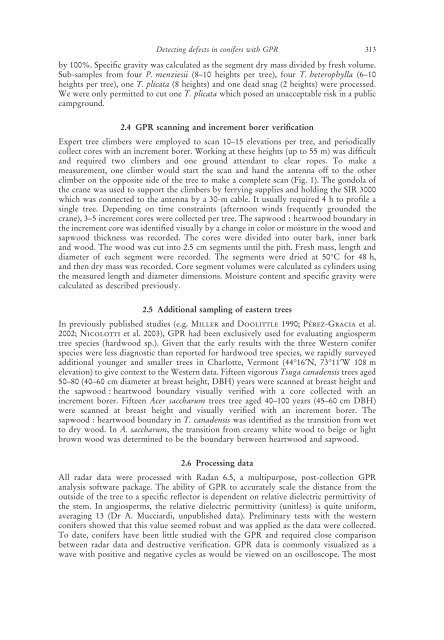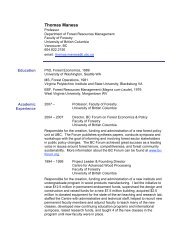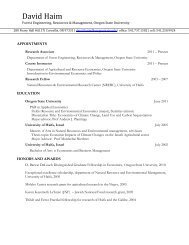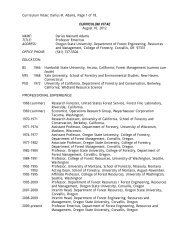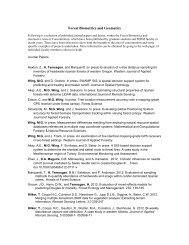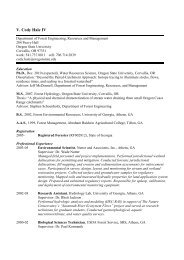Detecting defects in conifers with ground penetrating radar - Forest ...
Detecting defects in conifers with ground penetrating radar - Forest ...
Detecting defects in conifers with ground penetrating radar - Forest ...
Create successful ePaper yourself
Turn your PDF publications into a flip-book with our unique Google optimized e-Paper software.
<strong>Detect<strong>in</strong>g</strong> <strong>defects</strong> <strong>in</strong> <strong>conifers</strong> <strong>with</strong> GPRby 100%. Specific gravity was calculated as the segment dry mass divided by fresh volume.Sub-samples from four P. menziesii (8–10 heights per tree), four T. heterophylla (6–10heights per tree), one T. plicata (8 heights) and one dead snag (2 heights) were processed.We were only permitted to cut one T. plicata which posed an unacceptable risk <strong>in</strong> a publiccamp<strong>ground</strong>.3132.4 GPR scann<strong>in</strong>g and <strong>in</strong>crement borer verificationExpert tree climbers were employed to scan 10–15 elevations per tree, and periodicallycollect cores <strong>with</strong> an <strong>in</strong>crement borer. Work<strong>in</strong>g at these heights (up to 55 m) was difficultand required two climbers and one <strong>ground</strong> attendant to clear ropes. To make ameasurement, one climber would start the scan and hand the antenna off to the otherclimber on the opposite side of the tree to make a complete scan (Fig. 1). The gondola ofthe crane was used to support the climbers by ferry<strong>in</strong>g supplies and hold<strong>in</strong>g the SIR 3000which was connected to the antenna by a 30-m cable. It usually required 4 h to profile as<strong>in</strong>gle tree. Depend<strong>in</strong>g on time constra<strong>in</strong>ts (afternoon w<strong>in</strong>ds frequently <strong>ground</strong>ed thecrane), 3–5 <strong>in</strong>crement cores were collected per tree. The sapwood : heartwood boundary <strong>in</strong>the <strong>in</strong>crement core was identified visually by a change <strong>in</strong> color or moisture <strong>in</strong> the wood andsapwood thickness was recorded. The cores were divided <strong>in</strong>to outer bark, <strong>in</strong>ner barkand wood. The wood was cut <strong>in</strong>to 2.5 cm segments until the pith. Fresh mass, length anddiameter of each segment were recorded. The segments were dried at 50°C for 48 h,and then dry mass was recorded. Core segment volumes were calculated as cyl<strong>in</strong>ders us<strong>in</strong>gthe measured length and diameter dimensions. Moisture content and specific gravity werecalculated as described previously.2.5 Additional sampl<strong>in</strong>g of eastern treesIn previously published studies (e.g. Miller and Doolittle 1990; Pérez-Gracia et al.2002; Nicolotti et al. 2003), GPR had been exclusively used for evaluat<strong>in</strong>g angiospermtree species (hardwood sp.). Given that the early results <strong>with</strong> the three Western <strong>conifers</strong>pecies were less diagnostic than reported for hardwood tree species, we rapidly surveyedadditional younger and smaller trees <strong>in</strong> Charlotte, Vermont (44°16¢N, 73°11¢W 108 melevation) to give context to the Western data. Fifteen vigorous Tsuga canadensis trees aged50–80 (40–60 cm diameter at breast height, DBH) years were scanned at breast height andthe sapwood : heartwood boundary visually verified <strong>with</strong> a core collected <strong>with</strong> an<strong>in</strong>crement borer. Fifteen Acer saccharum trees tree aged 40–100 years (45–60 cm DBH)were scanned at breast height and visually verified <strong>with</strong> an <strong>in</strong>crement borer. Thesapwood : heartwood boundary <strong>in</strong> T. canadensis was identified as the transition from wetto dry wood. In A. saccharum, the transition from creamy white wood to beige or lightbrown wood was determ<strong>in</strong>ed to be the boundary between heartwood and sapwood.2.6 Process<strong>in</strong>g dataAll <strong>radar</strong> data were processed <strong>with</strong> Radan 6.5, a multipurpose, post-collection GPRanalysis software package. The ability of GPR to accurately scale the distance from theoutside of the tree to a specific reflector is dependent on relative dielectric permittivity ofthe stem. In angiosperms, the relative dielectric permittivity (unitless) is quite uniform,averag<strong>in</strong>g 13 (Dr A. Mucciardi, unpublished data). Prelim<strong>in</strong>ary tests <strong>with</strong> the western<strong>conifers</strong> showed that this value seemed robust and was applied as the data were collected.To date, <strong>conifers</strong> have been little studied <strong>with</strong> the GPR and required close comparisonbetween <strong>radar</strong> data and destructive verification. GPR data is commonly visualized as awave <strong>with</strong> positive and negative cycles as would be viewed on an oscilloscope. The most


